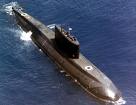|
Soviet Navy Kilo class, Project 877 and 636
 The concept and design of the Soviet Kilo class/Soviet`s Paltus started in the end of the 1970s out of the need to replace the successful ageing diesel-electrics Whiskey class, a medium sub for costal-shallow waters-the Baltic and Black Sea, and Foxtrot class, long –range ocean going submarine. This finally emerged as the Kilo class, a comparatively large general-purpose submarine of conventional but modern design which would be built both for the Soviet Navy and for export. The concept and design of the Soviet Kilo class/Soviet`s Paltus started in the end of the 1970s out of the need to replace the successful ageing diesel-electrics Whiskey class, a medium sub for costal-shallow waters-the Baltic and Black Sea, and Foxtrot class, long –range ocean going submarine. This finally emerged as the Kilo class, a comparatively large general-purpose submarine of conventional but modern design which would be built both for the Soviet Navy and for export.
The Russian Kilo Class, submarine first entered service in 1982. It was designed by the Rubin Central Maritime Design Bureau, St Petersburg. Subsequent developments have led to the production versions, the Type 877EKM/Soviet`s Varshavyanka later on followed by Type 636.
The Type 877EKM is designed for Anti-Submarine (ASW) and Anti-Surface ship (ASuW) Warfare.
The Project 636 design is a generally improved development of the Project 877EKM Kilo class. This submarine has improved range, firepower, acoustic characteristics, and reliability. Visually distinguished by a step on the aft casing, the length of the hull is extended by two frame spacing (2 x 600 mm). The additional length permitted increasing the power of diesel-generators and mounting them on improved shock-absorbing support, and reducing twofold the main propulsion shaft speed. Owing to these improvements, the submarine speed and sea endurance were increased, while the noise level was radically decreased. The low noise level of the submarine has been achieved with the selection of quiet machinery, vibration and noise isolation and a special anti-acoustic rubber coating applied on the outer hull surface.
Specifications, Kilo/Paltus class, Project 877:
Externally the Kilo resembles modern Western diesel submarines of her time with a shorter hull and increase in beam-remarkably similar to US Barbel and Dutch derivatives of the Zwaardvis and Walrus classes with an `Albacore` hull-form. Traditionally it retains the Soviet`s double-hull construction, six watertight compartments separated by transverse bulkheads, and the longer fin with the innovation of locating the forward hydroplanes beneath the deck casing just in front of the fin. To reduce the submarine`s acoustic signature, the flooding ports have been removed from the forebody, and the hull is covered with rubber anti-sonar protection tiles to reduce risk of detection. The Kilo is considered to be to be one of the quietest diesel submarines in the world. The submarine consists of in a pressurized double-hull.
Displacement (srf/sub tons): 2,325/3,076
Dimensions (L*B*D feet): 238`2*32`5*21`7, type 636-242`1
Propulsion: diesel electric, 2*1,825hp type 4-2DL-42M diesel-generators,1*5,900hp electric motor, 1 shafts (6 or 7 bladed propellers), type 636-4-2AA-42M
Speed (srf/sub knots): 10/17
Range (srf/sub n/miles@knots): snorting 6,000@7/400@3
Diving depth (feet): 985
Complement: 13 officers 39 enlisted
Missile: SSM-Sub launch anti-Ship Missilss, Novator Alfa SS-N-27 capabilities in part of the boats, SAM-Sub launch anti-Air Missiles, 8*Strela-3 (SA-N-8 Gremlin) or 8*Igla (SA-N-10 Gimlet)
Torpedo: 6*21" (533mm) bow torpedo tubes, total of 18 torpedoes
Mines: 24 in lieu of torpedoes
Armament: none
Construction
The submarines are constructed at the Admiralty Shipyard (Sudomekh), St. Petersburg and in the following shipyards aswell: Shipyard 199, Nizhniy Novgorod, Shipyard 112, Komsolol`sk-na-Amur . The Russian fleet operates three variants of the Kilo 877: the basic 877; the 877K that has an improved fire-control system; and the 877M that has wire-guided torpedoes from two tubes.
Export models, designated with an `E` suffix, are generally similar though with some reduced features. A total of 26 to 30 were built for the Russian Navy, all 30 Kilos submarines built for service with the Russian Navy are designated Project 877, although 15 of these are the earlier-developed 877/K/M and 15 the later 636 versions.
As of early 2000 less then half are believed to remain active.
They have also been exported as follows: China has two Type 877EKM and two Type 636, Iran has three Type 877EKM, India has ten Type 877EKM, Poland- one 877E, Romania- one 877E and Algeria- two 877E.
 |
India |
2006 |
President`s fleet review, Visakhapatnam, New Delhi, 12 Feb` 2006 |
 |
India |
2006 |
INS Sindhughosh S-55 (Soviet Kilo class,type 877) & INS Shishumar S-44 (type 209/2) |
 |
India |
2006 |
President`s fleet review, Visakhapatnam (sheet of 16 stamps) |
|